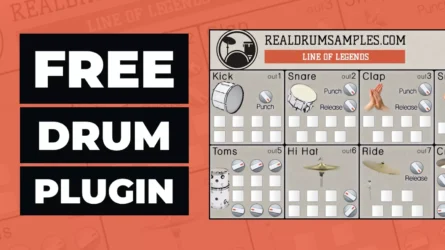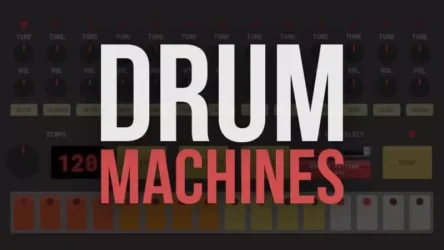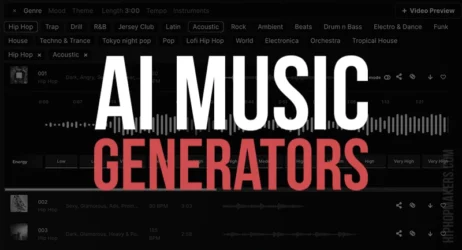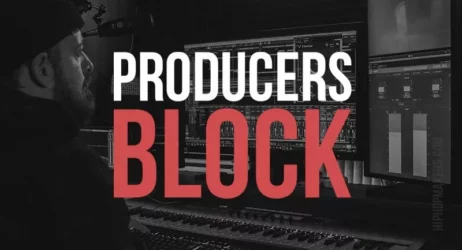This simple guide will answer what is form in music, the different types of form, musical form examples, and why they are essential.
What Is Form In Music?
Form in music is the organization and structure of a melodic composition. The term is used to specify either genre, type, or designate procedures used in a song. The classification of different kinds of musical forms is denoted by compositional techniques, functions, or performance.
- What is Form in Music
- Types Of Form In Music
- Examples Of Musical Form
- What Is Form Used For
- What Are The 3 Musical Forms
- How Do You Find The Form Of A Song
- Why Is Form & Structure Important
- Why Is Form Important In Music
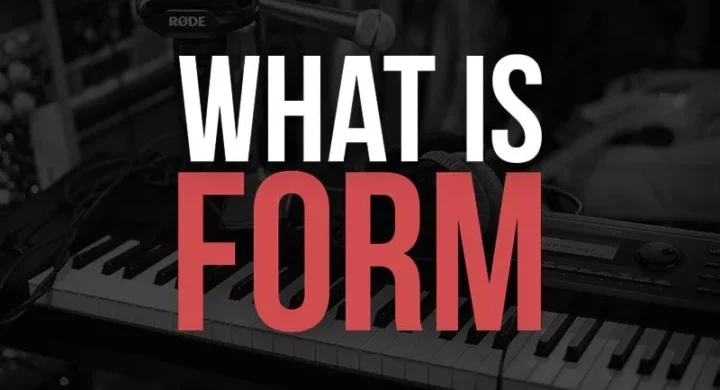
What is Form in Music?
Form in music, in layman’s terms, is the language and rules of music. It is the medium of the composition technique or by function or performance determined by the vocabulary for the different musical forms.
Form in music theory is defined as the organization and basic structure of a musical composition. A soundtrack can be divided into sections and assigned musical letters A, B, and C.
These letters help organize the music without sounding too clunky. Almost all forms of music can be grouped tighter in an umbrella term known as sectional forms.
Sectional form means that it can be divided into sections labeled with the letters A, B, and C.
The primary goal is to make sure that the soundtrack is musically correct and coherent on all requirements.
Song forms are used for structuring and organizing the music of a piece. It is used for joining along with a continuous melody by the seamless collection of all the sections, chorus, and lyrics pieced together to produce smooth audio for the song.
There is a massive list of types of musical forms to pick from because there are many probable choices when composing a tune.
These types include iterative, reverting, and progressive. Furthermore, types are strophic form, binary form, ternary form, rondo form, theme, variation, and sonata form.
Every soundtrack follows a particular set of rules and regulations to meet the criteria needed to qualify for a specific type of form in music. These aspects include harmony, melody, and rhythmic parts.
The musical Forms are divided into more manageable chunks. The level at the smallest measurement is called a bar.
The other organizing of such bars falls into the phrase, where the piece repeats more times. When such phrases start to take the shape of verse, it is called a passage of a song.
The next level refers to the entire sound music, where every aspect of harmony, melody, and rhythm starts to come together, which is called a piece or movement.
Finally, reaching the last level of the Form is referred to as cyclic form, and it means that the track features various self-contained movements into massive scale melodious composition.
What Are The Types Of Form In Music?
The basic types of Form in music are iterative, reverting, strophic, and progressive. Most of the types of forms are labeled under the “sectional forms” term. A sectional term means that the soundtrack can be divided into sections and assigned musical letters A, B, and C.
The iterative form is explained by the repetition of the exact phrase again and again. It is rare in Western music, but it is identified in Gregorian chant.
However, the reverting form is explained by repeating the exact phrase after a previously contrasting one. It was pretty standard in the Middle Ages with French ballade (a a b), virelai (A b b an A), and rondeau (A B a A a b A B), Italian ballata (A b b a A). The German bar form (a a b).
The Strophic form is used in the majority of musical forms and so referenced as song form or, verse song, or chorus form.
It follows the AAA structure, where a significant passage or a phrase is repeated throughout the track’s entirety, featuring various strophes or stanzas.
The progressive form is the one where a new musical phrase is inserted. It was popular in the 19th and 20th centuries.
What Are Examples Of Musical Form?
Any musical piece or genre of a song played anywhere from around the globe, regardless of any background, will be classified into a specific form in music. Often, we listen to iconic tunes without much importance to the structural integrity of the soundtrack.
The organized categories and types of musical forms neatly uphold the harmonic tunes needed for the natural progression of an orchestrated piece.
The following are examples of forms of music used in popular music along with a popular song:
- Strophic Form -“Amazing Grace”
- Binary Form – the folk song “Greensleeves.”
- Ternary Form – “Twinkle, Twinkle Little Star”
- Rondo Form – Beethoven’s “Fur Elise.”
- Theme and Variation – “Ah, vous dirais-je, Mama” by Mozart
- Sonata Form – Mozart’s “Eine Kleine Nachtmusik“
The iterative form is rare in Western music, but it is identified in Gregorian chant. However, the reverting form is explained by repeating the exact phrase after a previously contrasting one.
In the Middle Ages, it was pretty standard with French ballade, virelai, and rondeau, and Italian ballata (A b b a A). Or the German bar form (a a b).
The Strophic form is used in the majority of musical forms and so referenced as song form or verse song, or chorus form. The progressive form is the one where a new musical phrase is inserted, and it was popular in the 19th and 20th centuries.
What Is Form Used For?
Musical Forms are used for structuring and organizing the music of a piece. It is used for weaving along with a prominent melody by seamlessly joining all the sections, chords, and lyrics to produce smooth audio for the song.
The prime goal of the form is to make sure that the soundtrack is harmoniously sound and understandable in all aspects. There are many different ways to piece together a melody, so naturally, there are several types of forms in music to help organize them.
The many different breakdowns and labels help the composer draft a complete song with multiple building blocks needed.
What Are The 3 Musical Forms?
The three most basic forms of music are:
- Iterative and reverting forms
- Strophic form
- Progressive form
A much more detailed list of musical forms includes:
- v Through-Composed (ABCDE): It is a fully continuous composition where a large thematic piece is not repeated.
- v Binary (AB): It has two sections, similar in length and harmony.
- v Ternary (ABA): This form has three parts where the first and last parts share the same theme. These three sections can also be in large pieces.
- v Rondo (ABACA) or (ABACABA): The Rondo form follows the Binary and Ternary forms but with additional sections. The central theme is called the refrain, and contrasting sections are referred to as episodes.
- v Arch (ABCBA): The structure in these forms moves in an arc shape. The first three sections use new material, and after that, it starts to move into reverse order, ending on the same note as the beginning.
- v Sonata (Exposition, Development, Recapitulation): It is broken into three separate sections. These sections include the exposition, development, and recapitulation.
- v Theme and Variations: The starting section introduces the central theme, and immediately afterward, the first variation theme is launched. Every variation follows the same harmonic progression to weave together a complete piece.
How Do You Find The Form Of A Song?
Song Form is explained by the structure of songs in a neat routine. Letters are denoted to different sections in a piece where the same letters are used for repetition in a respective section. Thus, a single architecture is mapped out with the help of dividing the arrangement into easy-to-identify labels. These units are commonly assigned a letter – A, B, C, D, and so forth.
When one tries to find and analyze the form in music, one must place the said music in an available prototype. The soundtrack must match the rules needed to qualify in a specific form, such as restricted similarities in its melody, harmony, and rhythmic parts of form.
For example, a verse in a melody might get the letter A and then the chorus was called letter B because it’s different from the already assigned letter A. If the song’s structure is like verse, chorus, verse, chorus, then that song would be labeled ABAB.
Why Is Form & Structure Important In A Song?
Form and structure are essential in a song as it is the base on which the entire building of the soundtrack stands. It is the basis for a music piece to have a clear direction instead of random notes and chorus, which have no proper linkage to one another.
Artists use musical forms to shape and give balance to their tracks. Like the other musical elements, specific musical structures were used in various musical eras. The form, which provides organization, aids in showcasing a complete story that the composer envisioned.
Why Is Form Important In Music?
The importance of Form in music is to help organize and tie up a piece of music. The absence of a musical form would make the track incoherent and disjointed, which is why a musician must have a plan before they start to write their piece. In this way, writing music is similar to writing a story. If you don’t have a plan before writing, the end results will be less than ideal.
Summary of Form in Music
In music, form refers to the organization and entire structure of the melodic composition. The term can refer to either genre, types, or procedures used in a song. Different types of musical forms are classified according to compositional techniques, functions, or performance characteristics.
Understanding the different musical forms is essential to appreciating the art of music composition.
Binary form, ternary form, and sonata form are some of the most common forms used in classical music. In contrast, folk music and pop music often use verse form and medley form, which are more closely related to sectional forms like rondo form and rounded binary form.
Variation form and variational form are examples of musical forms where the same melody is presented in different ways, often with contrasting material.
These forms showcase the diversity of thematic material that can be derived from a single musical idea. Similarly, the development section of the sonata form, also known as the first movement form, explores different key relationships and offers a great example of music theory in action.
Through composed forms, such as composed and chain forms, are unique in that each section operates independently, often introducing a completely new theme.
This contrasts with more traditional forms, like ternary form sound and verse repeating form, where a familiar melody is repeated in the same key or a closely related one, like the relative major or minor key.
Hybrid song forms and arch forms demonstrate the versatility of musical composition, blending elements from multiple forms to create something new and engaging.
Whether in the realm of Western popular music or classical period masterpieces, these forms help shape the overall structure of a piece, guiding the listener through a rich tapestry of musical ideas.
As you explore the world of music production and composition, remember that many great works often incorporate multiple movements and forms. From the simplicity of a folk song in verse form to the complexity of a classical symphony with exposition material and contrasting themes, the diverse range of musical forms offers endless possibilities for creativity and expression.
I hope you found this information on the form in music helpful.

